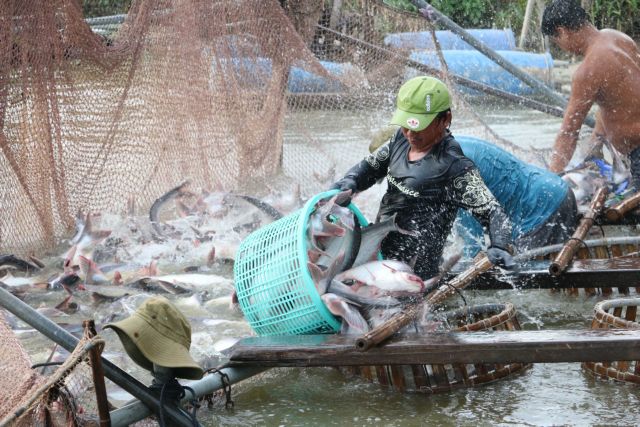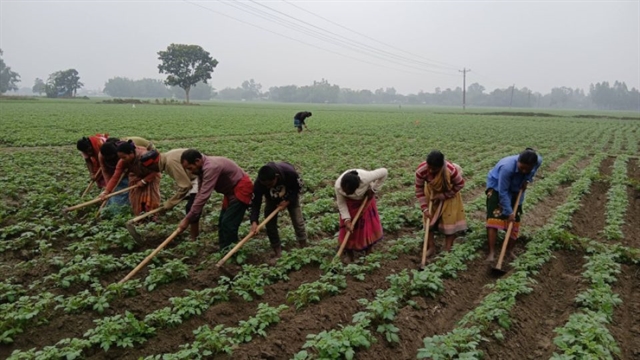 Society
Society

 |
| Farmers harvest tra fish in An Giang Province’s Châu Thành District. — VNA/VNS Photo Công Mạo |
ĐỒNG THÁP — Tra fish fry breeders should apply more new technologies to increase survival rates and reduce reliance on natural water resources, Phùng Đức Tiến, deputy Minister of Agriculture and Rural Development, said.
Speaking at a seminar held in Đồng Tháp Province on Thursday (August 18), Tiến said fish farmers in the Cửu Long (Mekong) Delta provinces, especially Đồng Tháp, should continue implementing the three-tier plan for production of high-quality tra fish breeds.
He instructed the Directorate of Fisheries to co-operate with the Research Institute for Aquaculture No 2, relevant research institutes and universities to supply tra fish breeders that produce fish fry to tra fish artificial reproduction establishments.
Under the three-tier co-operation plan, which was approved by the ministry in 2018, the first of the three tiers includes research institutes and universities using advanced techniques in selecting tra fish breeders, using tra fish breeding production techniques and transferring the techniques to the second tier.
The second tier includes provincial tra fish breed producing centres, tra fish breed nurseries, and the third-tier includes establishments that nurse tra fish from the newborn to fingerling stages.
The country has 103 tra fish artificial reproduction establishments and 1,913 establishments that nurse the newborn to the fingerling stage, mostly located in the delta’s provinces of An Giang, Đồng Tháp and Long An, and Cần Thơ City.
The establishments produced 15.9 billion newborn tra fish in the first seven months of the year, according to the Aquaculture Sub-departments of the delta’s provinces and Cần Thơ City.
After the newborn tra fish are nursed, they grow into fingerling size, and 2.2 billion fingerling size fry survived, up 10 per cent against the same period last year, the sub- departments reported.
Đồng Tháp is the delta’s largest tra fish fry producer.
The prices of tra fish fry sold in Đồng Tháp and An Giang provinces and Cần Thơ City are VNĐ27,000 - 30,000 a kilo for fry the size of 30 – 35 heads per kilo, and at this price, tra fish reproduction establishments make a profit.
Trần Hữu Phúc of the Research Institute for Aquaculture No 2 said since implementing the three-tier co-operation plan, the institute has supplied 60,000 tra fish breeders to tra fish artificial reproduction establishments.
This year, all 60,000 tra fish breeders are estimated to reach their reproduction ages and can produce 1.3 billion fish fry a year.
Như Văn Cẩn, head of the Directorate of Fisheries’ Aquaculture department, said: “The quality of tra fish fry has improved significantly but it is not in a comprehensive scale and the fry supply can not meet the demand during the peak breeding season.”
Some companies have applied advanced techniques in reproducing high-quality tra fish fry, he said.
However, the reproduction of high-quality fry still has several issues, he said.
The impact of climate change, saltwater intrusion and upstream water resources have affected reproduction as sometimes fry are infected with disease.
Newborn tra fish have a low survival rate as only about 15 per cent of them survive to reach fingerling size.
Other issues include the high production cost and the unclear origin of tra fish breeders.
Tiềm Ngọc Tiên, head of the Regional Animal Health Office No 7, said tra fish fry reproduction establishments should have plans to proactively monitor diseases, consider using vaccines to prevent diseases for tra fish and develop safe production chains to serve export requirements.
Tra fish is one of the country’s key exported seafood products.
The country harvested 982,000 tonnes of tra fish in the first seven months of the year, equal to the same period last year.
It exported $1.6 billion of tra fish products during the period, up 83.3 per cent from last year.
It expects to export $2.26 billion of tra fish products this year, up 80 per cent from last year, according to the ministry. — VNS




